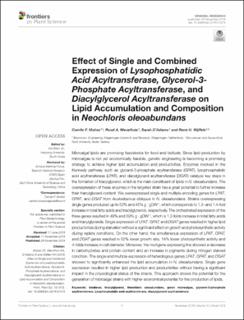| dc.contributor.author | Muñoz, Camilo F. | |
| dc.contributor.author | Weusthuis, Ruud A. | |
| dc.contributor.author | D'Adamo, Sarah | |
| dc.contributor.author | Wijffels, Rene Hubertus | |
| dc.date.accessioned | 2020-06-18T08:36:48Z | |
| dc.date.available | 2020-06-18T08:36:48Z | |
| dc.date.created | 2020-02-06T17:44:19Z | |
| dc.date.issued | 2019 | |
| dc.identifier.citation | Muñoz, C. F., Weusthuis, R. A., D'Adamo, S. & Wijffels, R. H. (2019). Effect of single and combined expression of Lysophosphatidic Acid Acyltransferase, Glycerol-3-Phosphate Acyltransferase, and Diacylglycerol Acyltransferase on lipid accumulation and composition in Neochloris oleoabundans. Frontiers in Plant Science, 10: 1573. doi: | en_US |
| dc.identifier.issn | 1664-462X | |
| dc.identifier.uri | https://hdl.handle.net/11250/2658581 | |
| dc.description.abstract | Microalgal lipids are promising feedstocks for food and biofuels. Since lipid production by microalgae is not yet economically feasible, genetic engineering is becoming a promising strategy to achieve higher lipid accumulation and productivities. Enzymes involved in the Kennedy pathway such as glycerol-3-phosphate acyltransferase (GPAT), lysophosphatidic acid acyltransferase (LPAT), and diacylglycerol acyltransferase (DGAT) catalyze key steps in the formation of triacylglycerol, which is the main constituent of lipids in N. oleoabundans. The overexpression of these enzymes in the targeted strain has a great potential to further increase their triacylglycerol content. We overexpressed single and multiple encoding genes for LPAT, GPAT, and DGAT from Acutodesmus obliquus in N. oleoabundans. Strains overexpressing single genes produced up to 52% and 45% g · gDW-1, which corresponds to 1.3- and 1.4-fold increase in total fatty acids and triacylglycerols, respectively. The orchestrated expression of the three genes resulted in 49% and 39% g · gDW-1, which is 1.2-folds increase in total fatty acids and triacylglycerols. Single expression of LPAT, GPAT, and DGAT genes resulted in higher lipid productivities during starvation without a significant effect on growth and photosynthetic activity during replete conditions. On the other hand, the simultaneous expression of LPAT, GPAT, and DGAT genes resulted in 52% lower growth rate, 14% lower photosynthetic activity and 4-folds increase in cell diameter. Moreover, the multigene expressing line showed a decrease in carbohydrates and protein content and an increase in pigments during nitrogen starved condition. The single and multiple expression of heterologous genes LPAT, GPAT, and DGAT showed to significantly enhanced the lipid accumulation in N. oleoabundans. Single gene expression resulted in higher lipid production and productivities without having a significant impact in the physiological status of the strains. This approach shows the potential for the generation of microalgal strains with higher economical potential for the production of lipids. | en_US |
| dc.language.iso | eng | en_US |
| dc.publisher | Frontiers | en_US |
| dc.rights | Navngivelse 4.0 Internasjonal | * |
| dc.rights.uri | http://creativecommons.org/licenses/by/4.0/deed.no | * |
| dc.title | Effect of single and combined expression of Lysophosphatidic Acid Acyltransferase, Glycerol-3-Phosphate Acyltransferase, and Diacylglycerol Acyltransferase on lipid accumulation and composition in Neochloris oleoabundans | en_US |
| dc.type | Peer reviewed | en_US |
| dc.type | Journal article | en_US |
| dc.description.version | publishedVersion | en_US |
| dc.rights.holder | © 2019 The Author(s) | en_US |
| dc.subject.nsi | VDP::Matematikk og Naturvitenskap: 400::Basale biofag: 470::Genetikk og genomikk: 474 | en_US |
| dc.source.pagenumber | 11 | en_US |
| dc.source.volume | 10 | en_US |
| dc.source.journal | Frontiers in Plant Science | en_US |
| dc.identifier.doi | 10.3389/fpls.2019.01573 | |
| dc.identifier.cristin | 1791779 | |

